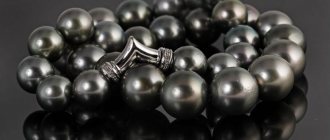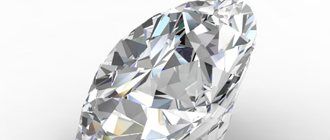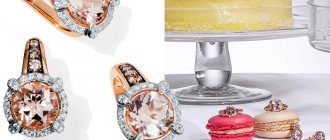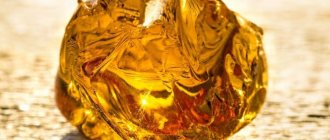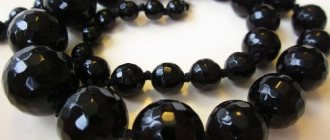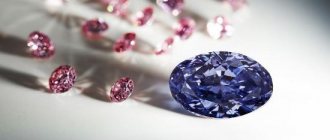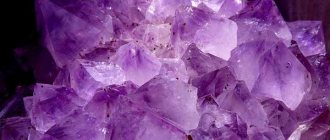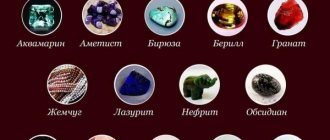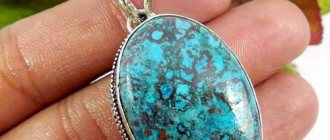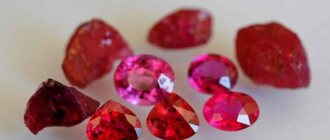Since ancient times, people have considered precious stones and minerals to be a symbol of wealth, attributed various magical properties to them and used them to create jewelry and amulets. More inconspicuous rocks have also found their use in site decoration and construction. There are many types of stones, both natural and synthetic, which differ in their properties, composition and application.
Properties of stones
Usually the word “stone” refers to naturally formed pieces and fragments of rocks. They can be either homogeneous in composition or consist of different groups of substances. There are also native stones, although they are quite rare.
Physical Features
Stones are tasteless and odorless solids. Most of them cannot be melted under high temperatures, but are only crushed into smaller parts. Their remaining physical properties, such as mass, size, transparency, density, structure and color, vary significantly among different species.
Stones in nature can be smooth and rough, dense and brittle, painted in almost all colors, from black and white to all shades of blue, cyan, red, pink, purple, green, sand, brown and others. There are also often options with stripes, patterns and iridescences, which give a very beautiful look even to not particularly valuable minerals.
Various forms of stones used in construction and other areas of life are divided into groups according to the following physical characteristics:
- Strength and wear resistance. There are rocks with high (granite), medium (marble) and low (tuff) parameters.
- Density. Rocks with an indicator of 2200/m³ are considered heavy, and less than this value are considered light.
- The ability to absorb water, which is due to the porosity of the mineral.
- Acid resistance. Some stones, such as marble, easily collapse under their influence, as they enter into a chemical reaction. The most stable rocks in terms of this parameter are granite and limestone.
From a chemical point of view
Rocks and minerals can have very different chemical compositions. Most often, they are based on metal oxides and salts, but other chemical compounds are also found, such as sulfides, carbonates, silicates, phosphates, borates, sulfates, halides, garnets and others. There are also stones made from native elements, such as diamond, which consists entirely of carbon C.
In addition to the chemical composition, the structure of the arrangement of atoms of a substance and the presence of impurities in it are also important. For example, emerald and ruby have the same chemical formula, Al₂O₃, but differ in appearance due to their different ability to absorb light.
Names of stones and their meaning
Now let's figure out what stones are used to make jewelry that can not only decorate, but also heal and bring benefits.
One of the most desirable for many girls is diamond, which consists of the main vital element - carbon. Diamond is considered a symbol of innocence, purity, wealth, success and happiness. It improves memory and helps its owners feel younger.
One of the most revered and beloved minerals all over the world is emerald. It not only fascinates with its beauty, but also has a number of mystical and healing properties, helping in the treatment of the stomach, bladder, head and joints. It is also indispensable in personal relationships, as it helps to calm down, refrain from rash actions, and remain faithful to your spouse.
Pearls are a mineral that is amazing in nature and also very popular in terms of jewelry. It takes at least 12 years for a grain of sand that falls into the shell of a mollusk to turn into this amazing stone. It means purity, prosperity, durability. Able to improve relationships with loved ones.
Very often, large gemstones are combined with zircon in jewelry. Zircon is a brittle mineral of crystalline nature. It is characterized by a strong diamond shine, for which this crystal is also called the younger brother of diamond. It is believed that this crystal is a stone of strength and power.
“Help identify a stone”: cheat sheet
Today the stars aligned - I decided to raise the burning question about stones, so dearly loved by many. Coldly beautiful, lying so comfortably and heavily in the hands and attracting the eye. Who can say with confidence that he has never been touched by the alluring beauty of stones? I don’t think there are anyone who is indifferent.
It just so happens that for a long time we have been using stones in handicrafts. Someone sells them, someone buys them. And more and more often, topics emerge from oblivion with the title: “Help me determine what kind of stone it is.” At best, the topic contains a photograph, where it is not always possible to even determine the color, not to mention the other characteristics of the stones. So what should we do?
Of course, it’s good when the reference book for those who deal with jewelry made from natural stones is “Fundamentals of Mineralogy.” But more often, phrases like: “trigonal system, ditrigonal-scalenohedral type of symmetry” can cause panic horror among non-specialists, and this is understandable - not all of us can be geologists, gemologists and mineralogists. Yes, this is not necessary. Let's take a little look at those qualifiers that we always have at hand.
To begin with, I would like to note: I would strongly not recommend purchasing many books that claim to be “identifiers” with titles like: “Stones and their properties.” One day not long ago, a lovely lady sent me a photo of the cover of her favorite book about stones, and what did I see? The brightest, most beautiful opal on the cover... lapis lazuli blue! They painted it well, so soulful! Eh, sorry, I didn’t save the picture.
But let's return to our “rams”.
Since it is unrealistic to cover the entire mineralogy course of the Faculty of Geology in one article, I will try to give you a number of tools-signs, a kind of cheat sheet that. I hope it makes life a little easier for those who are interested in this.
Imagine that in front of you are two stones: one of them is amethyst, and the second is fluorite. How to distinguish? We will build our further narrative around them.
What's the first thing we do? When we have the approximate name of that beautiful bead that our hamster requested for his bins after visiting the materials store, we start from it. Here I would like to note that almost any stone has, in addition to its mineralogical name, a bunch of local (given by workers at the mine, for example), commercial and outdated names. And very often this is just a tribute to the “poetic mood” of the person who named it - for example, rauchtopaz is not topaz at all, but quartz). Therefore, we look up synonyms on Wikipedia and study the properties of a stone by its mineralogical name, and not by poetry.
We type in Google: fluorite. The search gives us a hundred things! First desire: rush to look at the pictures, isn’t it? We struggle with ourselves and look at text information. We open the link not “healing properties”, not “photo/description” and other fluff. Open the Wikipedia article. How many times I looked through them, I didn’t come across any outright blunders, but in ordinary articles there were plenty!
Have you opened it? Wonderful. The first glance, not at the text, not at the pictures, but at the treasured sign in the left corner - this is the most important and valuable thing that should interest us.
And let's see what we can get out of this tablet without burdening ourselves with a gigantic amount of terminology.
1) Syngony. In our case, it’s a useless indicator - the beads are sold cut, we can’t look at anything under a microscope, and the terminology there is - don’t worry, mother! Let's skip it.
In the fluorite/amethyst example we took, a geologist would stop there - the cubic shape of the crystal would clearly show where the fluorite is. But we are considering a situation where we do not have a geological education.
2) Color. One of the most accessible indicators to us. We read carefully. Jade is not blue, obsidian is not pink, etc. (unfortunately, real examples from Yama).
In the example we took, the fluorite/amethyst color is similar.
3) Trait color. A very interesting and quite verifiable indicator is the color of the mineral in powder. To determine it, you need a porcelain unglazed, unvarnished, etc. surface. In geology, porcelain plates are used, which have the charming name “biscuit” (better known among students as “pichenka”)
How it works: take a pebble and press it across the porcelain. Almost black hematite, for example. has a cherry red streak.
And if we run a piece of turquoise across porcelain and see not a white line, but a green one, then this is not a stone, but a child of the paint and varnish industry!
In the fluorite/amethyst example we took, the color of the dash is the same.
4) Shine. In our case, it is most often a useless indicator - the shine looks on a fresh chip and you need a trained eye to determine it. Let's skip it.
5) Hardness. One of the most important indicators, which many people neglect - but for us it is salvation!
Geologists determine the hardness of minerals using the so-called Mohs scale. This is what it looked like when we were students (in last place, tenth, is a diamond, but for obvious reasons it was not given to students:
Principle: 10 standard minerals with a certain hardness are taken. A mineral with a higher hardness scratches softer minerals. Minerals with equal hardness scratch each other.
How this might work in our case: I'm not telling you to buy 10 minerals! One thing is enough - a piece of quartz . Perhaps you have one lying around among a bag of beads purchased by weight, one with a crack, or chipped, or with some other defect - do not throw it away, leave it for the standard (after making sure that it is quartz).
In the example we took, fluorite/amethyst, the hardness of fluorite is 4, amethyst is 7. Take a piece of quartz and scratch the first mineral. And we see that quartz scratches fluorite perfectly, with ease. But fluorite does not leave any traces on quartz. All. Determined what is what!
The complex of features: color, feature color, hardness turned out to be sufficient to distinguish fluorite from amethyst, without knowing what trigonal system is!
It’s so wonderfully possible to distinguish colored calcite from the many minerals for which it is passed off - just scratch it with quartz!
To determine hardness, it is sometimes recommended to scratch with a fingernail, a knife, glass... But you should be aware that everyone’s nails are different, and the steel of the knife can be different, and the hardness of the glass greatly depends on impurities (6-7 somewhere). If you suspect colored calcite, you can safely use it - it should not scratch the glass).
6) Cleavage. This is not a very useful indicator for us, unless you spare the bead and carefully split it with a hammer. Moreover, the bead should be large. It is unlikely that you will agree to such barbarity.
Cleavage is, roughly speaking, the ability to split in a strictly defined direction and in a certain shape. Determined by gradation: perfect/imperfect (well expressed/not expressed).
Perfect cleavage to the cube of galena
7) Kink. For us, this indicator is of little use for the same reasons. Nevertheless, I would like to draw attention to one fracture - the conchoidal one. A very characteristic feature, it cannot be confused with anything - it resembles a shell. Morion, flint, amethyst, opal...
 Density. You can determine by weight whether it is plastic or stone. But hardly any more. The refractive index is useless to us.
Density. You can determine by weight whether it is plastic or stone. But hardly any more. The refractive index is useless to us.
9) Useful information may be in the description text. For example, if you are reading about charoite, you should pay attention to the fact that there is only one deposit of this wonderful stone in the world. Accordingly, it cannot be sold at 10 rubles per bundle.
There are also characteristic features: iridescence, for example (such a beautiful radiance) in labradorite (which, by the way, is quite difficult to catch in a bead)
Let's summarize.
Let's look at what the purchased (or just looking at) stone is sold for. We read about it on the wiki - if it is not a mineralogical name, but a jewelry/local/trade name - we read about the mineralogical one. How to understand this? For example. We are recruiting our favorite chrysoprase, which has been sold in many places lately.
Wiki: “ Chrysoprase is a semi-precious and ornamental stone, a type of quartz and chalcedony...”
Let's go read about quartz and chalcedony, the properties of chrysoprase will be similar. We read further: “The color of the stone is usually apple green, but can vary to dark green and bluish green. Chrysoprase is a cryptocrystalline aggregate, that is, it consists of small crystalline grains indistinguishable to the naked eye, visible only under a microscope.” We conclude that a green transparent cannot be chrysoprase . Now remember how many of them are sold? Wow...
Why am I writing all this? Besides, you can, of course, mindlessly buy all the beautiful stones, make beautiful things out of them and be happy. But if the name of the stones is stated, perhaps it makes sense to make sure that the stones are exactly the same?
PS Having looked into my store, someone may be indignant - they say that he is engaged in decoupage, but here he is trying to tell something about stones. Let me calm you down a little - I am a geologist. It’s a pity that he has already left the profession, but amnesia has not yet struck! Greetings from the quarries seven years ago!
I hope you can learn something useful from the article. Much of it is simplified.
Good mood to everyone and have a great holiday!
Best wishes, your Gella.
Google lens - easily determine the name of the mineral from a photograph
Google lens or Google lens is an application similar to the one described above. It can search by uploaded photos, just like Yandex and Alice, but much simpler and easier.
What should be done:
- You can download the Android version from this link https://play.google.com/store/apps/details?id=com.google.ar.lens&hl=ru. Install and launch the application.
- The camera will open immediately. Point it at the stone and take a photo by clicking on the button at the bottom of the screen. Or download using the appropriate button on the left. In this case, you must be in the “Search” tab.
- As a result, you will receive similar images and descriptions for them, from which you will be able to understand the name of your stone from the picture.
The applications described above solve the problem in different ways: the first two are an updated interactive encyclopedia - they are more suitable for professionals who have at least some understanding of geology; and the last two are simpler and more convenient for amateurs, however, under some circumstances, for example, with a low-quality photo, they can give inaccurate results.
Varieties of gems
Varieties of gems
Most girls do not know the stones from which jewelry is made. But this information is important. There are 5 thousand minerals in nature. Many precious stones are used for jewelry. There are many different classifications of gems. One of the most popular is A.E. Fersman. According to it, gems are divided into three groups, in each of which subgroups (orders) are often distinguished.
Classification and name of stones:
- Precious. Rare and therefore the most expensive minerals, they are also the hardest and most durable. The highest (first) order includes sapphire, diamond, of all shades, emerald, ruby, as well as chrysoberyl, alexandrite. Gems of ideal purity and transparency, without foreign elements, cracks, and large sizes are most valued. This group sometimes includes zircon and some types of topaz.
- Semi-precious. They cost less, so they are widespread. However, the most unique representatives can be classified as precious stones. This category includes minerals such as opal, tourmaline, and chrysolite. Usually amethyst is also included in this group.
- Ornamental. The most beautiful specimens can be quite expensive. This category often includes jasper, turquoise, as well as rock crystal, quartz, and malachite with intricate patterns. The list of ornamental stones is complemented by vesuvian, sodalite, and the mysterious tiger and cat's eye. Typically, ornamental gems are represented by opaque minerals.
Photos and names of some stones that are used to create jewelry
Many precious stones that are found in the environment have been grown artificially. But natural gems are valued more highly because they can change a person’s mood and improve health.
To make a gem look beautiful, it is cut and polished.

